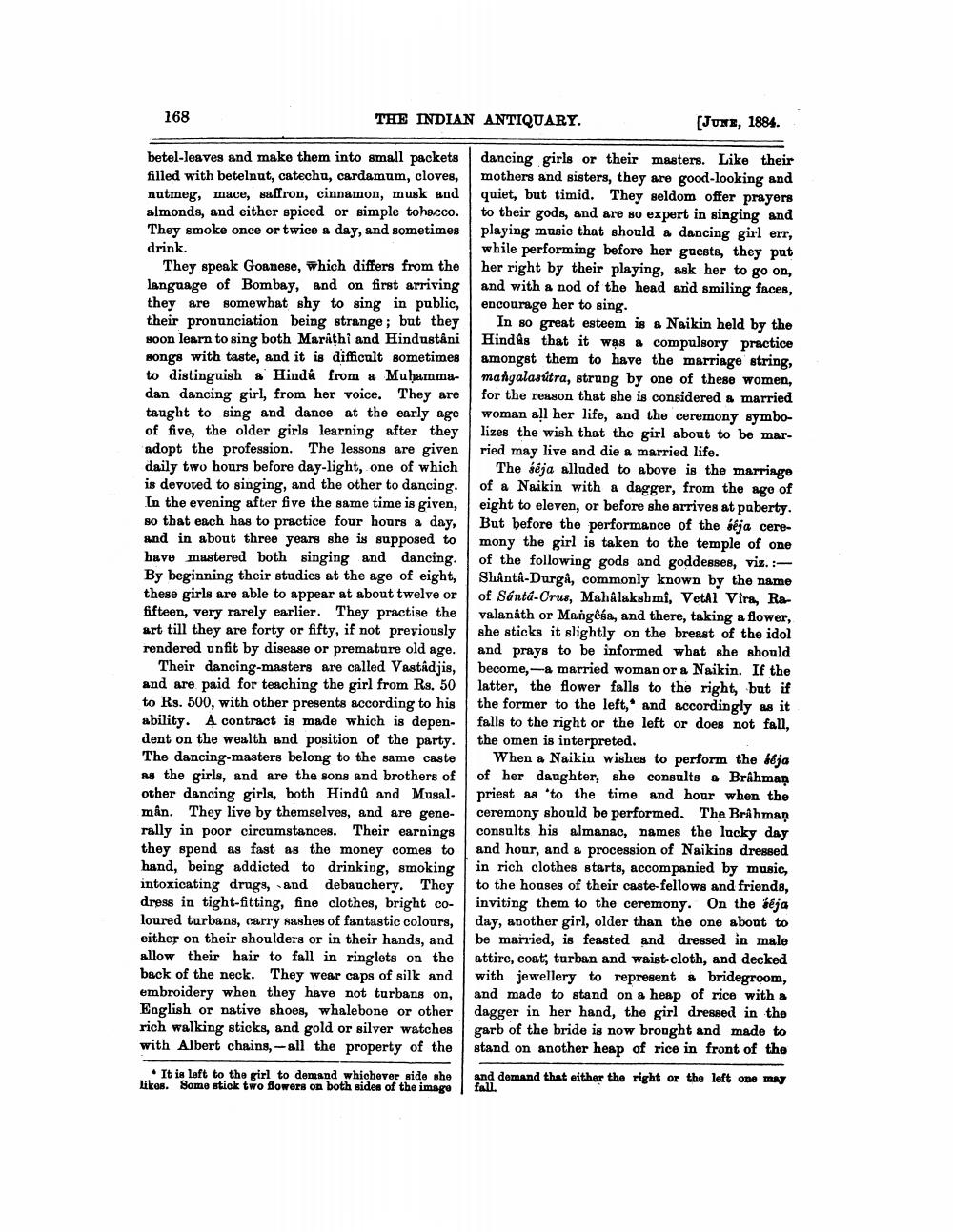________________
168
THE INDIAN ANTIQUARY.
[JUNE, 1884.
betel-leaves and make them into small packets dancing girls or their masters. Like their filled with betelnut, catechu, cardamum, cloves, mothers and sisters, they are good-looking and nutmeg, mace, saffron, cinnamon, musk and quiet, but timid. They seldom offer prayers almonds, and either spiced or simple tohecco. to their gods, and are so expert in singing and They smoke once or twice a day, and sometimes playing music that should a dancing girl err, drink.
while performing before her guests, they put They speak Goanese, which differs from the her right by their playing, ask her to go on, language of Bombay, and on first arriving and with a nod of the head and smiling faces, they are somewhat shy to sing in public, encourage her to sing. their pronunciation being strange; but they In so great esteem is a Naikin held by the Hoon learn to sing both Marathi and Hindustani Hinds that it was a compulsory practice songs with taste, and it is difficult sometimes amongst them to have the marriage string, to distinguish a Hindú from a Muhamma- mangalasútra, strung by one of these women, dan dancing girl, from her voice. They are for the reason that she is considered a married taught to sing and dance at the early age woman all her life, and the ceremony symboof five, the older girls learning after they lizes the wish that the girl about to be maradopt the profession. The lessons are givenried may live and die a married life. daily two hours before day-light, one of which The bêja alluded to above is the marriage is devoted to singing, and the other to dancing. of a Naikin with a dagger, from the age of In the evening after five the same time is given, eight to eleven, or before she arrives at paberty. so that each has to practice four hours a day, But before the performance of the seja cereand in about three years she is supposed to mony the girl is taken to the temple of one have mastered both singing and dancing of the following gods and goddesses, viz. :By beginning their studies at the age of eight, ShÅntA-Durga, commonly known by the name these girls are able to appear at about twelve or of Santa-Crus, Mahalakshmi, Votal Vira, Ra fifteen, very rarely earlier. They practise the valanith or Mangesa, and there, taking a flower, art till they are forty or fifty, if not previously she sticks it slightly on the breast of the idol rendered unfit by disease or premature old age. and prays to be informed what she should
Their dancing-masters are called Vastádjis, become,-a married woman or a Naikin. If the and are paid for teaching the girl from Rs. 50 latter, the flower falls to the right, but if to Rs. 500, with other presents according to his the former to the left, and accordingly as it ability. A contract is made which is depen- falls to the right or the left or does not fall, dent on the wealth and position of the party. the omen is interpreted. The dancing-masters belong to the same caste When a Naikin wishes to perform the kéja as the girls, and are the sons and brothers of of her daughter, she consults a Brahman other dancing girls, both Hindů and Musal. priest as to the time and hour when the min. They live by themselves, and are gene- ceremony should be performed. The Brahman rally in poor circumstances. Their earnings consults his almanac, names the lucky day they spend as fast as the money comes to and hour, and a procession of Naikins dressed hand, being addicted to drinking, smoking in rich clothes starts, accompanied by music, intoxicating drugs, and debauchery. Thoy to the houses of their caste-fellows and friends, dress in tight-fitting, fine clothes, bright co- inviting them to the ceremony. On the beja loured turbans, carry Rashes of fantastic colours, day, another girl, older than the one about to either on their shoulders or in their hands, and be married, is feasted and dressed in male allow their hair to fall in ringlets on the attire, coat, turban and waist-cloth, and decked back of the neck. They wear caps of silk and with jewellery to represent a bridegroom, embroidery when they have not turbans on, and made to stand on a heap of rice with a English or native shoes, whalebone or other dagger in her hand, the girl dressed in the rich walking sticks, and gold or silver watches garb of the bride is now brought and made to with Albert chains, -all the property of the stand on another heap of rice in front of the
It is left to the girl to demand whichever side she and demand that either the right or the left one may Likes. Some stick two flowers on both sides of the image




